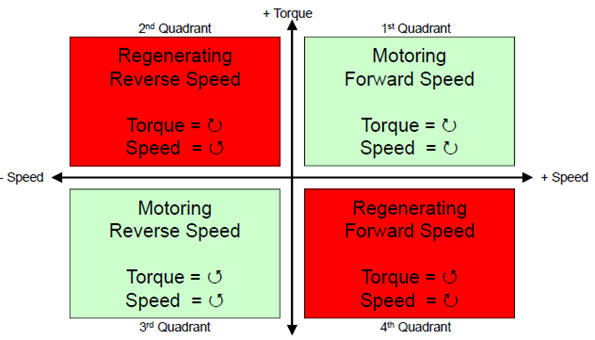VFD Stopping Techniques
Posted on Wednesday Jan 30, 2019 at 12:12AM in Electrical
We have a history of receiving inquiries on how to add braking to VFD applications. The terminology can often be challenging and confusing. There is always a possibility that the application is not a good fit. Below are three different types of braking techniques often used with a VFD.
What is Regenerative Braking?
Regeneration Braking occurs when a coasting or decelerating electric motor is driven by the load causing the motor to generate electricity. This is very similar to a generator. This can be best described using is a four-quadrant graph with Speed and Torque are plotted on X-Y Axis.
The motor is in “Regenerative Braking (REGEN)” when the following two combinations are met.
Combination 1:
Speed is Positive (+) and Torque is Negative (-)
Combination 2:
Speed is Negative (-) and Torque is Positive (+)
What is Regenerative Braking used for?
Regenerative Braking is used for applications that require continuous braking or have high inertia loads. This is the most expensive solution, but some of the cost can often be recovered by feeding the generated electricity back into a power grid. For example, this is similar to a conveyor that is running downhill where the weight on the belt causes the belt to move without a power driven motor.

What is Flux Braking?
Flux braking is a controlled method used to increase motor loss (slip). Motor loss, also known as slip, is the total difference in speed between the rotor speed and the rotating electrical field of the stator. When braking is required, the flux (current) in the motor is increased, which in turn increases the motor’s capability to brake. By raising the level of magnetization (current) in the motor, the load can be quickly decelerated. By increasing the flux in the motor, the energy of the mechanical system changes to thermal energy in the motor.

What is Dynamic Braking?
Dynamic Braking is where a braking chopper is used with a braking resistor. As the demand for braking increases, a switch turns on and bleeds the excess energy off to a resistor. Basically, the braking chopper serves as an electrical switch that connects the VFDs DC bus voltage and to a resistor, where the braking energy is converted into heat. During the deceleration period, the motor switches to a generator operation and supplies energy back through the inverter.

Summary:
- Regenerative Braking – Breaking energy is converted to electricity and returned to the grid
- Usually the most expensive solution
- Often requires a Regenerative Drive
- Can be used without limit
- Flux Braking – Uses current to create magnetic flux to stop a motor
- Good for lower horsepower(HP)
- Over fluxing reduces slip, which reduces the braking capability
- Usually the most cost efficient solution
- Can only be used intermittently due to the heat generated in the motor
- Dynamic Braking – Requires a brake chopper and brake resistor
- Power is dissipated by heat
- Brake Resistor must be sized by load and duty cycle
- Can only be used intermittently from heat generated from the resistor

